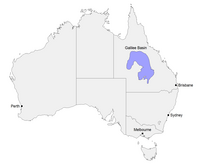
Photo from wikipedia
Abstract Late Miocene samples from the Xiaolongtan Formation in Puyang Basin were sampled systematically from bottom to top of the main coal seam. Organic petrological as well as geochemical methods… Click to show full abstract
Abstract Late Miocene samples from the Xiaolongtan Formation in Puyang Basin were sampled systematically from bottom to top of the main coal seam. Organic petrological as well as geochemical methods have been applied, aiming at the reconstruction of the depositional environment. The studied samples contain abundant detrovitrinite and liptinite macerals with high ash but low to moderate sulfur contents. This data indicates that the samples were deposited in topogenic mires without marine influence, but with fluctuations of water table and/or water influx which are mirrored by ash and sulfur content. The low values of tissue preservation and vegetation index, but high values of gelification index and groundwater index (GWIAC) in the studied coal imply a peat accumulation in inundated marshes under slightly oxic to anoxic depositional conditions with input of herbaceous plants mainly. An extended data set on vitrinite reflectance, volatile matter, Rock-Eval Tmax and HI suggests a coalification ranging from subbituminous C to B coal. The high concentration of long chain n-alkanes in the studied samples is typical for kerogen derived predominately from higher terrestrial plants. The applied biomarker ratios together with the detected hopenes further confirm the low thermal maturity level, as well as high water table and terrestrial organic matter input during peat accumulation. The variable concentrations of terpenoids and sesquiterpenoids suggest a dominant angiosperm input, but with a relatively high proportion of gymnosperms during some periods of peat deposition.
Journal Title: International Journal of Coal Geology
Year Published: 2020
Link to full text (if available)
Share on Social Media: Sign Up to like & get
recommendations!